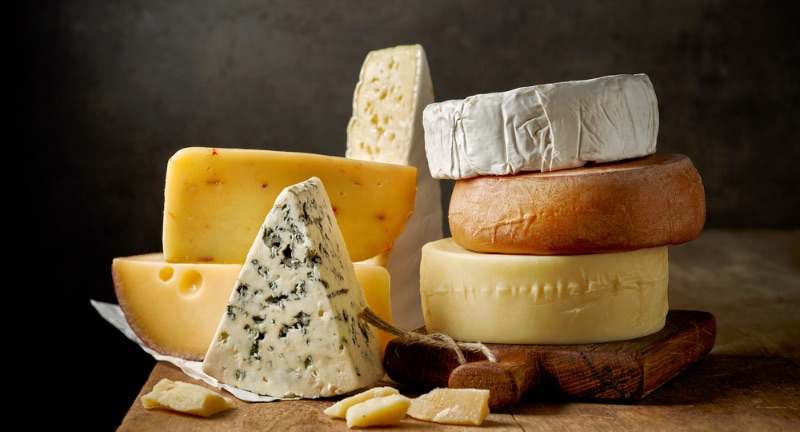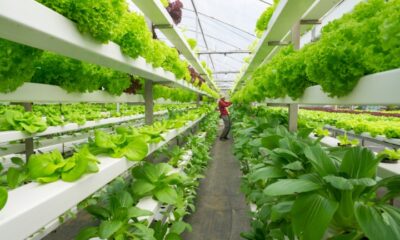ECONOMY
The Long History Of Cheese
Published
2 months agoon

Shutterstock
Cheese has a long history that runs through thousands of years. The art of cheesemaking has evolved through various stages, from ancient techniques to modern innovations, shaped by shifts in industry, demand, and scientific advancements. There are hundreds of different styles of cheeses all with their own stories and flavors. From traditional methods passed down through generations to cutting-edge technologies improving production, cheese is a grocery store staple. Today, the world of cheese is more diverse than ever before, showing how cultures can influence each other.
Earliest evidence of cheesemaking (5500 BCE, Poland)

Shutterstock
The earliest evidence of cheesemaking dates back to around 5500 BCE, discovered in Poland. Archaeologists found traces of dairy fats on pottery shards, suggesting early methods of milk processing. This discovery indicates that ancient civilizations were likely producing cheese long before written history. This early evidence shows that cheesemaking was already a part of the Neolithic lifestyle.
Domestication of milk-producing animals (9000–7000 BCE)

Shutterstock
The domestication of milk-producing animals such as cows, sheep, and goats occurred between 9000 and 7000 BCE. This shift was essential for the development of dairy-based foods like cheese. These animals provided a steady supply of milk, enabling early humans to experiment with various forms of dairy preservation. The domestication process paved the way for organized cheesemaking techniques that followed.
Use of animal stomachs as milk storage containers (Prehistoric era)

Shutterstock
In the prehistoric era, early humans used animal stomachs as containers for storing milk. This practice allowed milk to ferment naturally, aided by the enzymes present in the stomach lining, which contributed to curdling. These early storage methods were crucial for the first stages of cheese production. It also led to the discovery of how milk could be transformed into longer-lasting forms of food.
Discovery of rennet’s curdling properties (Unknown prehistoric time)

Shutterstock
The discovery of rennet’s curdling properties marked a significant milestone in the history of cheesemaking. Rennet, an enzyme found in the stomachs of young ruminants, facilitates the separation of curds and whey. This natural process enabled the creation of cheese with better texture and longer shelf life. The use of rennet revolutionized cheesemaking, making it a more efficient process for ancient civilizations.
Cheesemaking spreads in Mesopotamia (3000 BCE)

Shutterstock
By 3000 BCE, cheesemaking had spread to the Mesopotamian region, where it became an important part of daily life. Texts from this period indicate that cheese was used as both a dietary staple and a form of trade. The Sumerians, Assyrians, and Babylonians were known to have practiced early forms of cheesemaking. This helped establish a foundation for the development of cheese as a major food product in ancient cultures.
Egyptian tomb murals depicting cheesemaking (2000 BCE)

Shutterstock
Around 2000 BCE, ancient Egyptian tomb murals depicted scenes of cheesemaking, illustrating its significance in Egyptian society. These murals show workers making cheese from milk, emphasizing the practice’s long history in the region. The Egyptians valued dairy products for their nutritional benefits, and cheese was part of their daily diet. The visual evidence in these tombs helps us understand how cheesemaking was carried out in ancient times.
Cheesemaking in Minoan Crete (2000–1400 BCE)

Shutterstock
Cheesemaking was also practiced in Minoan Crete between 2000 and 1400 BCE, with evidence suggesting a refined process. Archaeologists have discovered tools and pottery that were used in dairy production. The Minoans likely used rennet and advanced techniques to produce various types of cheese. This discovery underscores the cultural importance of cheesemaking in the ancient Mediterranean world.
Greek texts mention cheese (8th century BCE, Homer’s “Odyssey”)

Shutterstock
Cheese is mentioned in ancient Greek texts, particularly in Homer’s “Odyssey” (8th century BCE), where it is referred to as a common food. The Greeks had a well-established tradition of cheesemaking, producing a variety of cheeses, including a form of feta. Cheese was commonly used in daily meals, offering a source of protein and fat. This literary reference indicates the widespread use and cultural importance of cheese in ancient Greece.
Romans innovate cheese production techniques (2nd century BCE)

Shutterstock
During the 2nd century BCE, the Romans began innovating cheese production techniques that spread throughout their empire. They developed methods for aging and flavoring cheese, introducing a variety of cheese types that were consumed across the empire. Roman cheeses were more sophisticated and varied, ranging from fresh cheeses to those aged for months. The Roman Empire’s expansion helped introduce cheesemaking to new regions, influencing future dairy practices.
Cheesemaking spreads throughout the Roman Empire (1st century CE)

Shutterstock
By the 1st century CE, cheesemaking had spread throughout the Roman Empire, becoming widespread across Europe. The Romans introduced more systematic methods for cheesemaking, improving the quality and consistency of the final product. Cheese became an integral part of Roman cuisine, with a growing demand for different types. This spread of knowledge helped establish cheesemaking as an important culinary tradition in Western civilization.
Cheese varieties diversify in Europe (Medieval period)

Shutterstock
During the Medieval period, cheese varieties began to diversify significantly across Europe. As trade routes expanded, different regions started producing their own unique types of cheese, each with distinct flavors and textures. Monasteries played a significant role in perfecting these cheese varieties, which were often used in religious offerings. Cheese became a staple food, especially in the diets of the peasant class.
Monasteries refine cheese production (5th–15th century CE)

Shutterstock
From the 5th to the 15th century CE, monasteries in Europe played a pivotal role in refining cheese production methods. Monks were instrumental in developing new techniques for aging, preserving, and flavoring cheese. They produced high-quality cheese that was often sold in local markets and was an essential part of monastic life. These innovations contributed to the spread of cheesemaking knowledge throughout Europe.
Parmesan cheese first made (13th century, Italy)

Shutterstock
Parmesan cheese was first made in Italy in the 13th century, originating in the Parma region. It was initially produced as a hard, long-aged cheese that could be stored for extended periods. Parmesan quickly became a staple in Italian cuisine, used in a variety of dishes. Its distinct flavor and texture set it apart from other cheeses produced at the time.
Gouda cheese developed (12th–13th century, Netherlands)

Shutterstock
Gouda cheese was developed in the Netherlands during the 12th and 13th centuries. Its popularity grew due to its smooth texture, mild flavor, and aging potential. Gouda was initially produced in rural areas and was traditionally made in small village dairies. Today, it is one of the most well-known cheeses worldwide.
Cheddar cheese emerges (12th–13th century, England)

Shutterstock
Cheddar cheese first emerged in England during the 12th and 13th centuries, originating in the village of Cheddar. It became widely known for its firm texture and sharp flavor, which improved with aging. By the 16th century, Cheddar had become the most popular cheese in England. Its success in the English market helped establish Cheddar as an iconic cheese worldwide.
Mozzarella made from water buffalo milk (13th century, Italy)

Shutterstock
Mozzarella cheese, originally made from water buffalo milk, was first produced in Italy in the 13th century. The cheese became a key ingredient in Italian cuisine, especially in pizza and pasta dishes. Mozzarella is known for its soft, elastic texture and mild flavor, which is retained through a process called pasta filata. This cheese’s popularity grew rapidly, both in Italy and internationally, over the following centuries.
Swiss cheese industry innovates techniques (19th century)

Shutterstock
The Swiss cheese industry made significant innovations in cheesemaking during the 19th century. Swiss cheesemakers perfected the technique of creating cheese with large holes, known as “eyes,” which became a defining characteristic of Swiss cheese varieties like Emmental. This innovation helped solidify Switzerland’s reputation for producing some of the finest cheeses in the world. Swiss cheesemaking techniques also spread to other parts of Europe and beyond.
Industrial cheesemaking begins (19th century)

Shutterstock
The 19th century saw the rise of industrial cheesemaking, which revolutionized the cheese industry. Innovations in machinery and mass production techniques allowed for the creation of cheese on a much larger scale than ever before. This shift in production methods led to the widespread availability of cheese, making it more accessible to people worldwide. Industrial cheesemaking also reduced the cost of production, which helped to make cheese an affordable product for the masses.
First cheese factory opens (1851, New York, USA)

Shutterstock
The first cheese factory was opened in 1851 in New York, USA, marking the beginning of large-scale cheese production in the country. The factory was set up to streamline the cheesemaking process, allowing for higher output and consistent quality. This innovation set the stage for the rapid expansion of the American cheese industry. It also allowed the country to become a leading producer and exporter of cheese.
Invention of rennet substitutes (1868)

Shutterstock
In 1868, the invention of rennet substitutes revolutionized the cheesemaking industry. These substitutes, made from plants and fungi, replaced animal-derived rennet, making cheesemaking more sustainable and humane. The development of these substitutes also made cheese production more efficient and less reliant on animal slaughter. This innovation was critical for the expansion of industrial cheesemaking across the world.
Development of pasteurization improves safety (19th century)

Shutterstock
The development of pasteurization in the 19th century had a significant impact on the safety of dairy products, including cheese. By heating milk to a specific temperature and then cooling it rapidly, pasteurization eliminated harmful bacteria and pathogens. This process greatly reduced the risk of foodborne illnesses, making cheese safer for consumption. It also extended the shelf life of cheese, allowing for wider distribution.
Processed cheese patented by James L. Kraft (1916)

Shutterstock
In 1916, James L. Kraft patented processed cheese, a new form of cheese that could be melted easily and had a longer shelf life. This development was aimed at providing a more convenient cheese product for consumers. Processed cheese soon became a staple in American households and found use in fast food chains and other commercial applications. Kraft’s innovation laid the foundation for the global processed cheese market.
Global cheese consumption increases (20th century)

Shutterstock
In the 20th century, global cheese consumption significantly increased, driven by industrial production and increased availability. Cheese became more widely recognized as a nutritious food, and its popularity grew around the world. Global trade in cheese expanded, with countries importing and exporting large quantities of cheese. The development of new cheese varieties, both traditional and processed, also helped fuel the rise in consumption.
Invention of mass-production equipment (20th century)

Shutterstock
The 20th century saw the invention of new mass-production equipment for cheesemaking, which further advanced industrial processes. These machines allowed for quicker and more efficient production of cheese in large quantities. Automation also played a key role in standardizing cheese production, ensuring consistent quality and flavor. These innovations made cheese production more scalable and helped meet the growing demand for dairy products worldwide.
Rise of artisanal cheesemaking movements (Late 20th century)

Shutterstock
In the late 20th century, the rise of artisanal cheesemaking movements marked a return to traditional cheesemaking methods. These movements focused on small-scale, high-quality production, emphasizing craftsmanship and regional ingredients. Artisanal cheeses became highly valued for their unique flavors and textures, and the movement gained significant popularity among consumers. It also helped foster a renewed appreciation for regional cheesemaking traditions around the world.
Introduction of GMO enzymes for rennet (1980s)

Shutterstock
In the 1980s, the introduction of genetically modified organisms (GMO) enzymes for rennet revolutionized cheesemaking. These enzymes, produced through biotechnology, provided a more consistent and sustainable source of rennet compared to animal-derived rennet. The use of GMO rennet helped address concerns about animal welfare and increased the efficiency of cheese production. This development made it easier for manufacturers to meet global demand while maintaining product quality.
Expansion of cheese exports globally (1990s)

Shutterstock
In the 1990s, cheese exports expanded globally, as international trade grew and demand for diverse cheese varieties increased. Countries began importing cheeses from around the world, leading to the globalization of cheese culture. This period saw the rise of new markets for European cheeses, as well as the development of cheese production in countries outside Europe. The increased movement of cheese across borders helped introduce consumers to a wide range of flavors and styles.
Development of plant-based cheese alternatives (21st century)

Shutterstock
In the 21st century, the development of plant-based cheese alternatives became a significant trend in response to growing demand for vegan and dairy-free products. These alternatives are made from a variety of plant-based ingredients such as nuts, soy, and coconut. As technology has advanced, these alternatives have become more similar in taste and texture to traditional dairy cheeses. The rise of plant-based cheese options has expanded the cheese market to a broader range of consumers with dietary preferences.
Advancement in cheesemaking technology (21st century)

Shutterstock
Advancements in cheesemaking technology in the 21st century have led to more precise control over the production process. Modern machines allow for consistent fermentation, curdling, and aging processes, resulting in higher-quality products. The use of sensors and automated systems has increased efficiency and reduced waste. These technological improvements have enabled cheesemakers to meet the demands of both traditional and contemporary cheese markets.
Preservation of traditional cheese practices recognized (21st century)

Shutterstock
In the 21st century, the preservation of traditional cheesemaking practices has gained global recognition. Many artisanal cheeses and traditional production methods are now protected through various certifications, such as Protected Designation of Origin (PDO) in Europe. These protections ensure that specific regions and their practices are recognized and preserved for future generations. The recognition of traditional cheese practices has helped maintain cultural heritage and support local cheesemakers around the world.
Conclusion

Shutterstock
As we’ve seen, the history of cheese is pretty extensive. If you are a fan of cheese like we are, we hope that you have appreciated learning something new about this wonderful food. Cheese had a humble beginning, but it is safe to say that it has made its mark. Cheese is like the Elvis of food, it seems. The evolution of cheese will definitely continue, getting yummier and yummier each year.
Related Topics:

More From Lifestylogy
-


20 Things People Mindlessly Spend Their Money On That Might…
-


Hardwood Is The Best: Here’s Why
-


To Buy or Not to Buy? The Realities of Homeownership
-


Why You Should Throw Out Your Cleaning Products
-


What Is Hydroponics, And Why Is It So Important?
-


24 Uses For Bananas That Are Oddly Practical
-


22 State Laws That Are Hard To Believe They Actually…
-


27 Habits To Implement That Could Change Your Life For…
-


26 Dirtiest Jobs In The World, Would You Brave One…